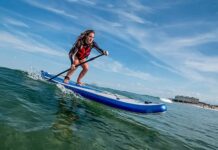Looking to take your fitness routine to the water? If you’ve been eyeing Stand Up Paddleboarding (SUP) as your next workout adventure, you might be wondering if wearing a helmet is necessary. In this article, we’ll explore the importance of helmets in SUP fitness and discuss whether they are a must-have accessory for your workouts on the water. Join us as we weigh the pros and cons and help you make an informed decision about staying protected while achieving your fitness goals on a paddleboard.
Why Wear a Helmet for SUP Fitness?
Protection from Head Injuries
When engaging in any type of physical activity, including SUP fitness, it is important to prioritize our safety. One of the main reasons to wear a helmet while participating in SUP fitness is to protect our heads from potential injuries. In the event of a fall or collision, a helmet acts as a barrier between our heads and the hard surface, reducing the risk of severe head trauma. By wearing a helmet, we can minimize the impact of such accidents and safeguard our well-being.
Safety Precautions
To ensure a safe and enjoyable experience during SUP fitness, it is crucial to take necessary safety precautions. Wearing a helmet is an essential part of this process. Whether we are beginners or experienced paddleboarders, accidents can happen unexpectedly. By wearing a helmet, we can proactively reduce the chances of sustaining a head injury, allowing us to focus on the fun and exhilaration of our SUP fitness activities.
Risk of Falling
SUP fitness involves balancing and maneuvering on a paddleboard, which naturally carries the risk of falling. Even the most skilled and experienced paddleboarders can lose their balance and find themselves in the water unexpectedly. When falling from a height, there is always a possibility of hitting our heads on the board or other objects in the water. Wearing a helmet serves as an effective preventative measure against such accidents, significantly reducing the potential for head injuries.
Impact of Water Conditions
The conditions of the water can vary greatly, ranging from calm and peaceful to rough and unpredictable. While participating in SUP fitness, we should always be prepared for changing water conditions and their potential impact on our safety. Strong currents, waves, or collisions with rocky structures can increase the risk of head injuries. Wearing a helmet provides an added layer of protection, ensuring that even in challenging water conditions, our heads are shielded from potentially harmful impacts.
Benefits of Wearing a Helmet
Apart from offering protection from head injuries, wearing a helmet during SUP fitness offers numerous other benefits. Firstly, it improves our overall confidence and focus, knowing that we have taken necessary precautions to ensure our safety. This mental assurance allows us to fully immerse ourselves in our fitness routine and maximize the benefits of our workout. Additionally, by wearing a helmet, we set a good example for others, promoting a culture of safety and responsible paddling. It also increases our safety awareness, encouraging us to be more cautious and vigilant while on the water. Lastly, by consistently wearing a helmet, we become a positive influence on our fellow paddleboarders, inspiring them to prioritize their safety as well.
Understanding SUP Fitness
What is SUP Fitness?
SUP Fitness, short for Stand-Up Paddleboard Fitness, combines the elements of traditional paddleboarding with various fitness routines. It involves performing exercises such as yoga, Pilates, strength training, and cardio activities on a paddleboard. SUP Fitness offers a unique and exciting way to stay fit and enjoy the tranquility of being out on the water. It provides a full-body workout that engages various muscle groups while challenging our core stability and balance.
Types of SUP Fitness
There are several types of SUP Fitness activities that cater to different fitness goals and preferences. Yoga SUP combines the meditative practice of yoga with the core-engaging experience of paddleboarding, enhancing both mental and physical well-being. HIIT (High-Intensity Interval Training) SUP workouts incorporate intense bursts of cardio exercises with periods of rest or lower-intensity exercises, boosting cardiovascular health and endurance. Additionally, SUP Pilates focuses on strengthening and toning muscles through controlled movements, utilizing the instability of the paddleboard to engage the core even further.
Popular SUP Fitness Activities
SUP Fitness has gained immense popularity in recent years, attracting individuals of all ages and fitness levels. Some of the most popular SUP Fitness activities include SUP Yoga, SUP Bootcamp, SUP CrossFit, and SUP Barre. These activities offer a unique combination of strength, flexibility, balance, and cardiovascular training while enjoying the scenic beauty of the water. Whether we prefer a relaxing yoga session or a high-energy bootcamp, SUP Fitness provides a versatile range of options to suit our preferences.
Types of Helmets for SUP Fitness
Traditional Cycling Helmets
Traditional cycling helmets are a popular choice for SUP fitness enthusiasts who prioritize versatility and comfort. These helmets are designed to provide excellent impact protection and are widely available in different sizes and styles. They offer full head coverage and typically feature adjustable straps to ensure a secure fit. While not specifically designed for water sports, many traditional cycling helmets are designed to handle water exposure and can work effectively for SUP fitness activities.
Water Sports Helmets
For those seeking dedicated water sports helmets, there are options specifically designed for activities such as SUP fitness. These helmets are constructed with materials that can withstand water exposure and have features that promote improved buoyancy and drainage. Water sports helmets often include adjustable chin straps, removable ear protection, and vents to enhance breathability. They are designed to provide optimal protection while also accommodating the unique needs and challenges of water-based activities.
Full-Face Helmets
Full-face helmets offer comprehensive head and face protection, making them a suitable choice for individuals engaging in more extreme forms of SUP fitness. These helmets are designed with a rigid face shield to shield the entire face from potential impacts. While they may be bulkier and less suitable for activities requiring extensive mobility or agility, full-face helmets provide an extra layer of protection in situations where there is a higher risk of facial injuries.
Adjustable Helmets
Having a properly fitting helmet is essential when it comes to ensuring our safety during SUP fitness. Adjustable helmets are designed with straps and buckles that can be easily adjusted to fit our head size and shape. These helmets offer a customizable fit, providing stability and security during our activities. The adjustability feature also allows us to find the perfect balance between snugness and comfort, ultimately enhancing our overall experience.
Factors to Consider when Choosing a Helmet
Certifications and Standards
When selecting a helmet for SUP fitness, it is crucial to prioritize safety and choose a helmet that meets recognized certifications and standards. Look for helmets that are certified by organizations such as the Consumer Product Safety Commission (CPSC) or other relevant regulatory bodies. These certifications ensure that the helmet has undergone rigorous testing and meets the necessary safety requirements.
Fit and Comfort
A properly fitting helmet is essential to ensure optimal protection and comfort. When choosing a helmet, consider the circumference of your head and select a size that matches your measurements. The helmet should fit snugly without being too tight, and it should not wobble or shift during movement. Additionally, consider helmets with adjustable straps and padding for a customized and comfortable fit.
Ventilation
Ventilation is another important factor to consider, as it can greatly impact comfort during SUP fitness. Look for helmets with well-placed vents that allow for airflow and help regulate temperature. Proper ventilation reduces the chances of overheating and discomfort, ensuring a more enjoyable experience on the water.
Adjustability and Stability
Helmets that offer adjustability features such as adjustable straps, buckles, or multi-point sizing systems provide a more customizable fit. These helmets allow us to fine-tune the fit to our specific head shape, ensuring stability and minimizing the risk of the helmet coming off during a fall or other sudden movements.
Durability
Durability is a crucial aspect to consider when investing in a helmet for SUP fitness. Since paddleboarding involves exposure to water and potential impact, choose a helmet made from durable materials that can withstand the wear and tear of regular use. Look for helmets with a sturdy outer shell and reliable fastening systems to ensure their longevity.
Risks Involved in SUP Fitness
Possibility of Falling
Falling is an inherent risk associated with any physical activity, including SUP fitness. While paddleboarding itself is relatively safe, unexpected factors such as waves, wind, or loss of balance can result in falls. Depending on the circumstances, falls can lead to head injuries if proper precautions, such as wearing a helmet, are not taken. By recognizing the possibility of falling and taking proactive measures, such as wearing a helmet, we can minimize the potential risks.
Head and Brain Injuries
Head and brain injuries can have severe and long-term consequences on our health and well-being. The impact of hitting our heads on hard surfaces, such as paddleboards, rocks, or other objects, can result in concussions, fractures, or more severe traumatic brain injuries. While a helmet cannot completely eliminate the risk of head injuries, it significantly reduces the impact force and provides a layer of protection that can potentially mitigate the severity of such injuries.
Impact with Objects
During SUP fitness activities, there is always a risk of colliding with objects in the water, such as buoys, boats, or submerged obstacles. These collisions can occur unexpectedly and result in head injuries if precautions are not taken. Wearing a helmet adds an extra layer of protection, reducing the physical impact and potential damage caused by such collisions.
Unexpected Water Conditions
Water conditions can change rapidly and unexpectedly, especially in open bodies of water. Even on a calm day, strong currents, unexpected waves, or wind gusts can lead to challenging situations. SUP fitness enthusiasts need to be aware of these risks and prepare accordingly. Wearing a helmet can help protect our heads in the event of unexpected falls or collisions, providing an added sense of security in challenging water conditions.
Expert Opinions and Recommendations
Professional SUP Athletes
Many professional SUP athletes emphasize the importance of wearing a helmet during SUP fitness activities. They understand the potential risks involved and acknowledge that even the most skilled paddleboarders can experience unexpected falls or accidents. By setting an example and consistently wearing helmets, professional athletes communicate the importance of safety and inspire others to prioritize their well-being.
Safety Organizations
Safety organizations, such as the American Canoe Association (ACA) and the National Association of State Boating Law Administrators (NASBLA), consistently advocate for wearing helmets during water-based activities, including SUP fitness. These organizations are committed to educating individuals on water safety and encourage the use of proper safety equipment to minimize the risk of injuries.
Fitness Instructors
Fitness instructors who specialize in SUP fitness are well-aware of the potential risks involved in these activities. They often emphasize the importance of wearing helmets to their clients, encouraging them to prioritize safety and make informed decisions. These instructors promote a culture of safety and create an environment where participants feel supported and educated about the potential risks and best practices of SUP fitness.
Benefits of Wearing a Helmet for SUP Fitness
Protection from Head Injuries
The primary benefit of wearing a helmet during SUP fitness is the protection it offers against head injuries. By acting as a cushion between our heads and potential impact surfaces, helmets reduce the risk of severe trauma in the event of a fall or collision. Choosing to wear a helmet can provide us with peace of mind and allow us to fully enjoy our SUP fitness activities, knowing that we have taken necessary precautions to protect our heads.
Improves Confidence and Focus
Wearing a helmet can significantly enhance our confidence and focus during SUP fitness. Knowing that we have taken measures to prioritize our safety allows us to concentrate on the activity at hand. We can fully immerse ourselves in our fitness routine without unnecessary worry or distractions, thereby maximizing the benefits of our workout and achieving a sense of accomplishment.
Sets a Good Example
By wearing a helmet, we set a positive example for others who may be observing our behavior on the water. Whether it is fellow paddleboarders or younger enthusiasts, our commitment to safety highlights the importance of making responsible choices. Setting a good example through helmet usage can encourage others to prioritize their safety and inspire a culture of safe paddleboarding practices.
Increases Safety Awareness
Consistently wearing a helmet during SUP fitness increases our overall safety awareness. By actively choosing to protect our heads, we develop a heightened sense of caution and attentiveness while on the water. This increased awareness can extend beyond wearing a helmet and lead to a more mindful and cautious approach in all aspects of our paddleboarding journey.
Positive Influence on Others
Being a positive influence on our fellow paddleboarders is an important role we can play while participating in SUP fitness. By wearing a helmet, we inspire others to take their safety seriously and make informed decisions. Our commitment to safety can ripple through the paddleboarding community, creating a more safety-conscious and responsible environment for all.
Arguments Against Wearing a Helmet
Lack of Comfort
Some individuals may argue that helmets can be uncomfortable, especially during physical activities like SUP fitness. While it is true that helmets may feel unfamiliar or slightly restrict movement initially, advancements in helmet design have allowed manufacturers to prioritize comfort without compromising safety. By choosing helmets with appropriate padding, adjustable straps, and ventilation systems, we can find a helmet that offers both protection and comfort.
Limited Field of Vision
Another argument against wearing a helmet during SUP fitness is that it may limit our field of vision. However, many helmets designed for water sports have features and design elements that ensure an adequate field of vision. Manufacturers carefully consider the positioning of the helmet’s visor and incorporate designs that provide maximum visibility while still providing head protection. With a well-fitted helmet, the limitations to the field of vision can be minimized.
Restricting Mobility
Critics of helmet usage argue that helmets can restrict mobility and hinder the fluidity of movements during SUP fitness activities. While it is true that helmets add an extra layer of weight and bulk, advancements in helmet technology have resulted in lightweight materials and streamlined designs aimed at minimizing mobility restrictions. It is important to select a helmet designed for sports activities and ensure it fits securely to minimize any potential mobility restrictions while on the water.
Interference with Performance
Some individuals participating in SUP fitness may argue that wearing a helmet can interfere with their performance during certain activities, such as SUP Yoga or advanced paddleboard maneuvers. While it is true that helmets can require some adjustment and adaptation, the potential risks of head injuries far outweigh any potential impact on performance. With practice and familiarity, individuals can learn to adjust their movements and adapt to the presence of a helmet, ensuring their safety does not compromise their performance.
Tips for Wearing a Helmet during SUP Fitness
Proper Fitting and Adjustment
To ensure optimal safety, it is essential to ensure a properly fitting helmet. Take the time to measure your head circumference and select a helmet size accordingly. Once you have the helmet, follow the manufacturer’s guidelines for adjusting the straps and chin buckle. The helmet should fit snugly but comfortably, allowing for proper protection and stability during SUP fitness activities.
Helmet Maintenance
Regular helmet maintenance is crucial to ensure its effectiveness and longevity. After each use, rinse the helmet with fresh water to remove any salt or debris. Allow it to air dry thoroughly before storing it in a cool and dry place. Avoid exposing the helmet to excessive heat or direct sunlight, as this can degrade its materials. Regularly inspect the helmet for any signs of damage or wear, and replace it if necessary.
Education and Training
It is always beneficial to educate ourselves about water safety and SUP fitness techniques. By understanding the potential risks and dangers associated with paddleboarding, we can better appreciate the importance of wearing a helmet. Enroll in certified SUP fitness classes or seek guidance from experienced instructors who can provide valuable insights and recommendations about helmet usage and safety practices.
Regular Inspections
Regularly inspecting our helmet is essential to ensure it remains in good condition and provides the necessary protection during SUP fitness activities. Check for any visible signs of wear, such as cracks, loose straps, or damaged padding. If any issues are detected, it may be time to replace the helmet. Regular inspections and maintenance can help us avoid potential safety hazards and stay protected on the water.
Conclusion
In conclusion, wearing a helmet during SUP fitness is a responsible and important decision that can significantly enhance our safety and well-being. By providing protection from head injuries, helmets minimize the impact of falls, collisions, and unexpected water conditions. They also offer a range of benefits, such as improved confidence and focus, setting a good example for others, and increasing safety awareness. When choosing a helmet, consider factors such as certifications, fit and comfort, ventilation, adjustability, and durability. While there may be arguments against wearing a helmet, advancements in design and technology have minimized potential drawbacks, ensuring that helmets can provide both protection and comfort. By following tips such as proper fitting and adjustment, helmet maintenance, education and training, and regular inspections, we can enjoy our SUP fitness activities with the peace of mind that comes from prioritizing our safety. So, the next time we head out for a paddleboarding session, let’s remember to strap on our helmets and enjoy the thrill of SUP fitness while keeping our heads protected.






































